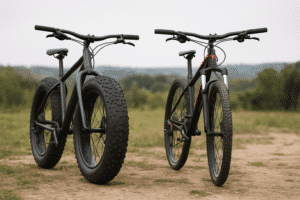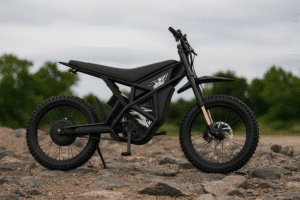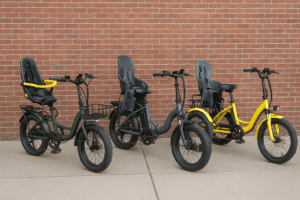If you’re trying to choose between a 20-inch and a 26-inch electric bike, wheel size can make a big difference in how the bike rides, handles, and fits your lifestyle.
This guide breaks down the real-world pros and cons so you can pick the size that works best for your body, terrain, and daily routine.
Key Summary:
- A 20-inch e-bike offers more torque and easier handling in tight urban spaces.
- A 26-inch e-bike provides more comfort, better speed retention, and off-road capability.
- Choose 20″ for portability, city riding, and quick starts.
- Choose 26″ for long commutes, comfort, and rough terrain.
Why Wheel Size Matters More Than You Think
Wheel size changes how an e-bike feels, how fast it accelerates, how smooth it rolls, and how easily you can store or transport it.
A smaller 20-inch wheel creates more torque at the ground, which means faster takeoff and tighter turning.
These bikes feel agile and are often easier to handle, especially if you’re riding in the city or need something foldable.
On the other hand, 26-inch wheels offer a smoother and more stable ride, especially at higher speeds or on bumpy terrain.
They’re better at maintaining momentum, which can save battery life and reduce fatigue on long rides. If you’re planning to cruise on open roads or take on gravel trails, the larger wheels usually feel more relaxed and efficient.
20-Inch Electric Bikes – Compact, Nimble, and Quick
20-inch e-bikes are built for riders who want convenience and quick handling without giving up electric power. They’re popular in urban areas, among short riders, and with anyone tight on space.
Who They’re Best For
These bikes are a smart fit if you’re looking for flexibility, compact design, and quick maneuvering.
- Shorter riders or teens: Easier to mount and handle
- Urban commuters: Navigate traffic and tight turns with ease
- RV or apartment dwellers: Easy to carry and store
- Delivery riders: Quick acceleration helps in stop-and-go traffic
- Older adults or beginners: Lower standover makes mounting simpler
Pros
20-inch electric bikes punch above their size in a few key ways.
- Faster acceleration – Smaller wheels deliver more torque to the ground
- Better low-speed control – Ideal for stoplights, crowds, and crosswalks
- Compact and lightweight – Many fold up or fit in a car trunk
- Lower center of gravity – Adds balance when starting or stopping
- Often cheaper – Smaller frames and components can lower the price
Cons
While compact, 20-inch wheels have some real trade-offs too.
- Rougher ride – Smaller wheels absorb less shock unless fat tires or suspension are added
- Feels twitchy at speed – Not as stable when going over 20 mph
- Loses momentum faster – Takes more effort (or battery) to keep cruising
- Less suited for off-road – Smaller tires can sink in sand, snow, or deep gravel
26-Inch Electric Bikes – Stable, Smooth, and Efficient
If comfort, speed, or off-road versatility matter most to you, 26-inch electric bikes are the safer bet. These bikes ride like traditional bicycles but with extra power.
Who They’re Best For
These are a great match for riders who want a smoother and more comfortable experience.
- Taller riders – Fit and proportions feel more natural
- Rural or trail riders – Handle gravel, grass, and dirt with better traction
- Long-distance commuters – Better efficiency means longer range
- Heavier riders – Larger wheels and frames offer better support
- Anyone riding over 20 mph – More control at higher speeds
Pros
There’s a reason 26-inch wheels are still the default for most full-size e-bikes.
- Smoother ride – Bigger wheels roll over bumps and cracks with less bounce
- Better momentum – Rolls farther with less effort
- More battery-efficient – Uses less power at steady speeds
- Higher ground clearance – Good for trails or uneven roads
- Feels more like a traditional bike – Easier transition for experienced cyclists
Cons
But bigger isn’t always better, depending on where and how you ride.
- Less portable – Harder to fit in cars or apartments
- Heavier frame and wheels – Not ideal if you need to carry it upstairs
- Slower acceleration – Takes longer to get going from a stop
- More expensive – Higher-quality parts and suspension drive up the price
What is the Difference Between a 20-Inch and 26-Inch Electric Bike?
The main difference between 20-inch and 26-inch electric bikes is how they ride and what they’re built for. A 20-inch e-bike is smaller, more portable, and accelerates quicker, while a 26-inch e-bike offers more stability, smoother rides, and better efficiency at higher speeds.
Ride Feel Comparison: What You’ll Actually Notice
If you’ve never tried both, the difference in ride feel might surprise you. From turning and braking to how each bike handles bumps, your experience can change a lot depending on wheel size.
Stability vs Agility
A 20-inch e-bike feels zippy and responsive in tight turns, especially at low speeds. It’s easy to maneuver through crowded streets or weave around obstacles.
But when the road opens up, a 26-inch bike holds its line better. The larger wheelbase adds stability, which is noticeable when cruising above 20 mph or riding on uneven terrain. You’ll feel more planted and less jittery, especially downhill.
Handling and Braking Differences
With a smaller 20-inch wheel, you get tighter turning but also a more reactive feel. Every bump or steering input is more noticeable. This can be great in the city, but less ideal at high speed.
Braking also feels different. 20-inch bikes tend to stop quicker due to less rotating mass. But a 26-inch bike delivers smoother deceleration, which feels more natural when slowing from a higher cruising speed.
Suspension Matters Too
A 26-inch wheel rolls over obstacles more easily, which naturally smooths out the ride. But 20-inch bikes often need some help, that’s where suspension forks or seat post shocks come in.
If your 20-inch e-bike has no suspension, you’ll feel every pothole. But add a decent front fork or fat tires, and you’ll get much closer to the comfort of a larger-wheeled ride.
Either way, suspension makes a big difference, especially on rough roads.
Which One Should You Choose?
Both 20-inch and 26-inch electric bikes have their place, but the right choice depends on your height, riding habits, and where you plan to ride most.
Go 20″ If You Need:
- A compact bike for tight spaces like apartments or RVs
- Quick acceleration for stop-and-go city traffic
- An easier ride to handle if you’re shorter or want a low standover height
- A foldable e-bike that fits in your car or under your desk
- Better control at low speeds or in crowded areas
Go 26” If You Want:
- A smoother, more stable ride at higher speeds
- Better efficiency for longer distances and hill climbing
- More comfort on bumpy roads, trails, or off-road terrain
- A bike that feels like a traditional bicycle
- A good fit if you’re taller or plan to haul gear
Final Words
Choosing between a 20-inch and a 26-inch electric bike comes down to how you ride and what feels right for your lifestyle.
If you’re after agility, portability, and quick starts, a 20-inch bike might be just right. If you value comfort, stability, and covering longer distances, a 26-inch e-bike is hard to beat.
No matter what size you go with, the most important thing is that it fits your needs, your body, and your ride plans. Try both if you can. The feel speaks louder than the specs.
FAQs
Can you ride long distances on a 20-inch e-bike?
Yes, you can. But compared to a 26-inch e-bike, it may feel less comfortable over time, especially if the road is rough or you’re riding at higher speeds.
Are 20-inch wheels too small for tall riders?
Not necessarily. Some 20-inch e-bikes have longer frames or fat tires that still fit riders over 6 feet. But taller riders often prefer 26-inch wheels for better leg extension and balance.
Is a 20-inch e-bike slower than a 26-inch?
Not off the line. In fact, 20-inch wheels usually accelerate faster. But a 26-inch bike holds speed better and feels more stable at cruising speeds, especially over longer distances.
Which is safer: a 20-inch or a 26-inch e-bike?
At high speeds or on rough terrain, 26-inch bikes tend to feel safer due to better stability. That said, 20-inch bikes are easier to handle at low speeds and in tight spaces, which can also help you avoid accidents.
Al Amin Morshed is the founder of BoltBikers and a seasoned e-bike reviewer with years of hands-on experience testing electric bikes. As a long-time e-bike enthusiast, he combines real-world riding insights with in-depth research to create honest, helpful content for riders of all levels. Through BoltBikers, Morshed aims to make e-biking more accessible, practical, and enjoyable – whether you’re a new rider or a daily commuter looking for the best gear.








